|
Way back in 1982, I was perusing the
tables at a Nashville gun show, as I am prone to do, and came
across a table that contained but one rifle, but that big rifle
was like nothing that I had ever seen before! Upon the table was
a semi-automatic rifle that chambered the .50 caliber Browning
Machine Gun cartridge, and standing behind the table was the
young man who had designed and built the rifle, Ronnie
Barrett. At the time, I was only 23 years old, and Ronnie
wasn’t much older, but we stood and discussed his new rifle
for quite a while. Being a brand new father at the time, and
paying an enormous interest rate on a new house, I was as broke
as a convict, and there was no way that I could buy his rifle,
but Ronnie took the time to show his new rifle to anyone who was
interested. Thankfully, a customer that was very interested was
the US Army. Barrett has now manufactured and sold many
thousands of his rifles, and I finally
was able to buy one for myself a few years ago. Starting
with that one rifle design, Ronnie Barrett has added several
other rifle designs to his product line.
While at the Barrett manufacturing facility back
in 2004 shooting the then-new Barrett
Model 468, I was shown, but not allowed to photograph, a
new optical computer system that was being designed to allow
precision long range marksmen to make their shot quickly without
having to do a lot of ballistic calculations. That new ranging
device came to be known as the Barrett Optical Ranging System (BORS), and is the subject of this review.
A precision target shooter, military sniper, or
police sniper has several factors to consider when determining
his scope settings for making a long range shot. For most of us,
we can monkey around with scope knobs and take a few shots
getting everything on target. For some shooters, such as our
military snipers, they will get one shot, and it has to be on
target or things do not go well. The shooter has to take into
account the distance to target, elevation, temperature, and the
angle up or down to the target, along with the wind and any
obstacles which might be in the way. It can take several minutes
to calculate these factors. The BORS calculates many of these
factors for the shooter, making his job easier and more precise.
The BORS constantly monitors temperature, barometric pressure,
and the degree of angle to the target. The BORS calculates the
effects of these factors upon the ballistics of the bullet, and
allows the shooter to worry only about doping the wind. While
the BORS can determine the distance to target also, I prefer to
use a laser rangefinder for that, as it is quicker, easier, and
more precise. The BORS calculates distance much the same way as
does a Mil-Dot system, depending upon the shooter knowing the
size of the target being ranged. For instance, if the shooter
determines that his target is a six-foot tall man, and uses the
BORS to determine the range, the calculation is only precise if
the target is indeed six feet tall. If the target is only five
feet four inches, the calculation is off by a great deal, which
could result in a miss. That is why Barrett recommends using a
laser rangefinder, and to rely upon the range finding
capabilities of the BORS as a backup. The BORS unit calculates
all of the difficult stuff that has an effect upon the
ballistics of a cartridge, allowing the shooter to dope the wind
and dial in the distance to target. The BORS does everything
else except pull the trigger.
The BORS unit weighs about thirteen ounces, and
mounts atop the rifle scope. For now, the unit will mount atop
several of the Leupold Mark 4 series scopes, and there
are models in the works to mount atop Nightforce and
other quality scopes. Barrett sells the BORS with or without a
Leupold scope. Having a couple of Leupold Mark 4 scopes on hand,
I ordered the BORS unit without the scope. The BORS comes with
everything needed to bolt it on and go to work. It has its own
set of very heavy duty rings that will attach to any Weaver or
Picatinny style base. The BORS comes with 100 different loads
already programmed into the unit, and with a ballistic software
CD to allow the user to program his own specific load into the
BORS by use of a supplied cable which connects the BORS unit to
a personal computer.
Upon opening the box, I was intimated by the
BORS and its software. Thinking that I would need some help with
thing. I am pretty much a novice when it comes to computers and
such, but after reading the supplied manual, the BORS is very
simple to understand and to operate. If I can do it, you can do
it. There are four buttons atop the BORS that allows the
operator to scroll through the available loads, either the 100
that are preloaded or those programmed in by the user, and
everything is observed on the LCD screen. Once set up for the
preferred load, the shooter simply turns the unit on, dials in
the range, and shoots. The BORS does the rest, with the
exception of adjusting for the wind. That is still the
shooter’s responsibility.
The BORS arrived just in time for me to carry it
on my annual pilgrimage to the NRA
Whittington Center near Raton, New Mexico. While I have
a dandy shooting range at my place, I only have 100 yards at my
rifle range. At the Whittington Center, I can shoot out to
several hundred yards, and on that dry, dusty ground, misses are
easy to spot. I mounted the BORS-equipped Leupold atop a new DPMS
rifle that I had been wanting to try out. It is their
top-of-the-line LRT-SASS model, and is probably the best
long range .308 semi-auto rifle in production. The SASS comes
equipped with a very comfortable, adjustable buttstock, a
free-floated eighteen inch heavy fluted blackened stainless
steel match barrel, a pretty decent adjustable trigger, a Harris
bipod, a railed handguard, superb backup sights, and a very
effective muzzle brake/flash hider. I have owned and fired
several AR-10 style rifles, but this baby is equipped better for
long range precision shooting than any that I have ever fired.
It also comes supplied with two steel nineteen-round detachable
magazines, sling, hard case, and cleaning kit. Weighing in at
eleven and one-half pounds, it is no lightweight, but it is also
not excessively heavy, and is a superb platform for launching
long, sleek, match-grade .308 bullets. This is one fine rifle. I
like it enough that I cut out my heavy duty Hardigg
Storm Case to fit the rifle with the Leupold/BORS
mounted.
As a side note, if you have a desire for a rifle
of this type, now would be the time to get one. With the 2008 US
Presidential election upon us, the presumptive Democrat Party
nominee has already vowed to outlaw semiautomatic rifles, and I
don’t have a lot of faith in the Republican nominee sticking
with his pledge to protect Second Amendment rights. Get one
while you can.
Scrolling through the loads programmed into the
BORS, I found one that closely matched the Buffalo Bore
.308 Sniper ammo that I prefer for long range shooting. Out of
the eighteen inch DPMS barrel, it clocks its 175 grain Sierra
match King bullet at 2574 feet-per-second (fps), ten feet from
the muzzle. The BORS has a load listing that same bullet at 2550
fps, and I used that for my initial setting. Sighting in the
rifle at 100 yards as per Barrett’s instructions, the
rifle/ammo combination proved to be extremely accurate. After
sighting in the BORS, I dialed the adjustment turret until it
read 200 yards on the screen, and fired three shots at a paper
target, with my brother Boge doing the spotting. As I
fired each shot, I thought that he was lying to me, as he was
proclaiming that they were landing in the same dern hole. Those
first three shots landed in a group measuring only one-quarter
inch center-to-center, at 200 yards! That is the best group that
I have ever fired, from anything. Satisfied with the superb
accuracy displayed by the rifle/scope/ammo, I proceeded to shoot
at life-size steel targets of mule deer, antelope, and black
bear at distances of 400 and 600 yards. Dialing the BORS in to
these distances was quick and easy, with just a turn of the
knob. The distance was displayed upon the LCD screen. With very
little wind on that morning, holding dead on and pulling the
trigger, using the bipod as a rest, hits were very easy to make.
Moving the next morning out to the long range silhouette range,
we had a heavy cross wind, but using the windage marks on the
Leupold reticle and dialing in the BORS made hits out to 1130
yards just a matter of pulling the trigger. Once the windage was
corrected, hits were effortless, and other shooters who had
never before fired the rifle were making hits reliably as well.
Some of the targets on this range were fired upon at a downward
angle, and the BORS took care of that problem as well. Holding a
rifle level when shooting at far away targets is imperative, and
the indicator on the BORS screen tells the shooter when the
rifle is out of level.
The BORS unit was designed with the military in
mind, but it is also a great tool for the rest of us. Suggested
retail price at the time of this writing is a quite reasonable
$1500 US. That is a lot less than I had expected it to be. It
takes a lot of guesswork and mathematical calculation out of
making long range precision shots. Mounted atop the excellent
and amazingly accurate DPMS LRT-SASS rifle, working in harmony
with the Leupold Mark 4 scope, the Barrett Optical Ranging
System is a first-class way to shoot. You never regret buying
the best.
Check out the BORS and other Barrett products
online at www.barrettrifles.com.
To order the Buffalo Bore .308 Sniper ammo, go
to www.buffalobore.com.
To look at the Mark 4 and other fine Leupold
products, go to www.leupold.com.
For more information on the DPMS rifles, go to
www.dpmsinc.com.
Jeff Quinn
|

Jeff shoots the SASS rifle with Leupold scope and
BORS at the NRA Whittington Center near Raton, NM.

Jeff mounted the BORS onto a Leupold Mark 4 8-25x scope.

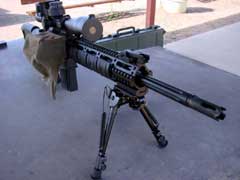
Jeff then mounted the BORS-equipped Leupold upon a DPMS
LRT-SASS .308 rifle.

Leupold scope retains windage adjustment.
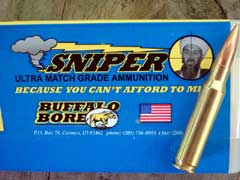
No rifle is more accurate than the ammo fed
through it, and Buffalo Bore's Sniper Ultra-Match ammo delivers
every time.

The SASS is the most accurate rifle of any type
that the author has ever fired, as this 1/4"
200-yard group demonstrates. The BORS system made
long-range shooting easy.

|
  
Got something to say about this article? Want to agree (or
disagree) with it? Click the following link to go to the GUNBlast Feedback Page.
|
|
Click pictures for a larger version.

The Barrett Optical Ranging System.

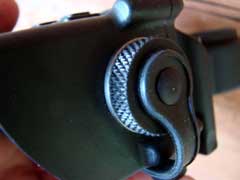

The BORS comes with all mounting hardware & computer
software.



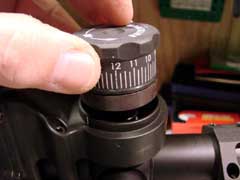
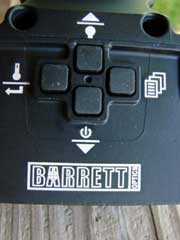
Operator controls.






Typical screen readings.


Very tough & strong mounting system.
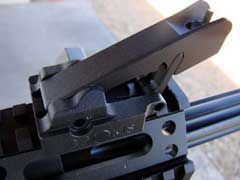





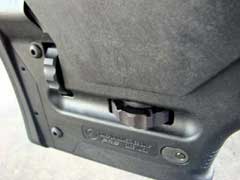
The awesome SASS rifle features (top-bottom) fold-down
sights, muzzle brake, bipod, free-floated heavy fluted barrel,
and adjustable buttstock.
|
![]()